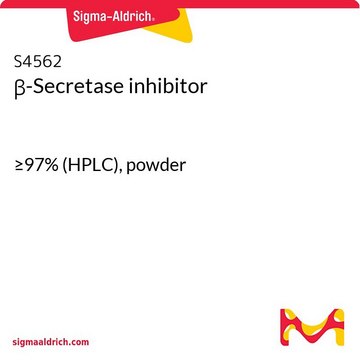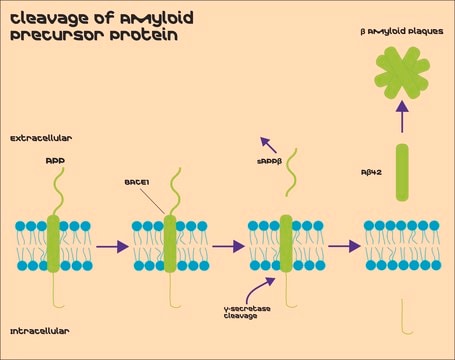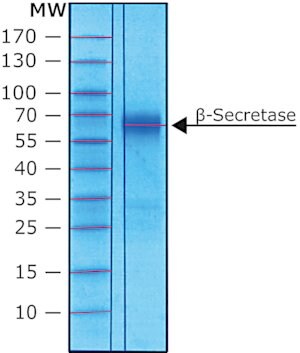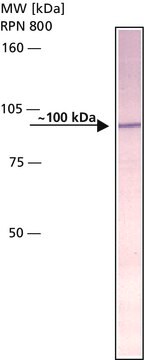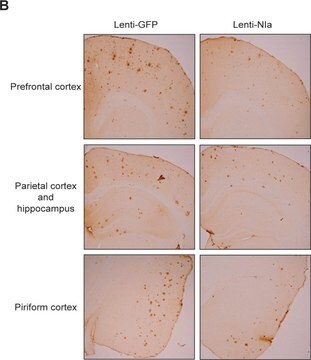S4316
Amyloid Precursor Protein β, Secreted human
recombinant, expressed in E. coli (N-terminal histidine tagged), solution
Synonym(e):
Amyloid Precursor Protein β, Secreted, sAPPβ
Anmeldenzur Ansicht organisationsspezifischer und vertraglich vereinbarter Preise
Alle Fotos(1)
About This Item
Empfohlene Produkte
Verwandte Kategorien
Allgemeine Beschreibung
Amyloid-β (Aβ) peptides are a major component of the senile plaques characteristic of the Alzheimer brain. It is a type- I transmembrane protein. The gene encoding amyloid-β is localized on human chromosome 21.
Anwendung
Human amyloid precursor protein β has been used as peptide standard.
Biochem./physiol. Wirkung
The secreted amyloid precursor β (sAPPβ) is a proteolytic cleavage product of β amyloid precursor protein (APP). APP is cleaved by β-secretase into two fragments, sAPPβ and β-amyloid peptide (Aβ). The Aβ is a component of amyloid plaques, one of the major hallmarks of Alzheimer`s disease (AD), while the sAPPβ is thought to modulate neuronal function and cell survival. Mutation in APP found in Swedish familial AD pedigree increases the susceptibility of APP to β-secretase cleavage and the formation of Aβ and sAPPβ. In contrast, activation of protein kinase C (PKC) decreases the levels of sAPPβ. The trans-Golgi network (TGN) is the major site for β-secretase activity.
Physikalische Form
0.2 μm filtered solution in 20 mM Tris (pH 7.4), 0.5 M NaCl, 1 mM EDTA, 5 mM βME, 2 μg/ml aprotinin
Angaben zur Herstellung
sAPPβ was expressed in E. coli as a soluble protein and purified under non-denaturing conditions
Lagerklassenschlüssel
10 - Combustible liquids
WGK
WGK 1
Flammpunkt (°F)
Not applicable
Flammpunkt (°C)
Not applicable
Persönliche Schutzausrüstung
Eyeshields, Gloves, multi-purpose combination respirator cartridge (US)
Hier finden Sie alle aktuellen Versionen:
Besitzen Sie dieses Produkt bereits?
In der Dokumentenbibliothek finden Sie die Dokumentation zu den Produkten, die Sie kürzlich erworben haben.
D J Selkoe
Nature, 399(6738 Suppl), A23-A31 (1999-07-07)
Studies of the molecular basis of Alzheimer's disease exemplify the increasingly blurred distinction between basic and applied biomedical research. The four genes so far implicated in familial Alzheimer's disease have each been shown to elevate brain levels of the self-aggregating
The Processing of Amyloid Precursor Protein in the
Central Nervous System of Humans and Rhesus
Macaques
Central Nervous System of Humans and Rhesus
Macaques
Justyna Anna Dobrowolska
The West Virginia Medical Journal (2013)
Monomeric Amyloid Beta Peptide in Hexafluoroisopropanol Detected by Small Angle Neutron Scattering.
Zhang-Haagen B
PLoS ONE (2016)
C Haass et al.
Nature, 357(6378), 500-503 (1992-06-11)
Progressive cerebral deposition of the amyloid beta-peptide is an early and invariant feature of Alzheimer's disease. The beta-peptide is released by proteolytic cleavages from the beta-amyloid precursor protein (beta APP), a membrane-spanning glycoprotein expressed in most mammalian cells. Normal secretion
D M Skovronsky et al.
The Journal of biological chemistry, 275(4), 2568-2575 (2000-01-25)
The release of amyloidogenic amyloid-beta peptide (Abeta) from amyloid-beta precursor protein (APP) requires cleavage by beta- and gamma-secretases. In contrast, alpha-secretase cleaves APP within the Abeta sequence and precludes amyloidogenesis. Regulated and unregulated alpha-secretase activities have been reported, and the
Artikel
Alzheimer's disease (AD) is the most common cause of dementia in the elderly and is characterized by gradual loss of cognitive functions.
Unser Team von Wissenschaftlern verfügt über Erfahrung in allen Forschungsbereichen einschließlich Life Science, Materialwissenschaften, chemischer Synthese, Chromatographie, Analytik und vielen mehr..
Setzen Sie sich mit dem technischen Dienst in Verbindung.
